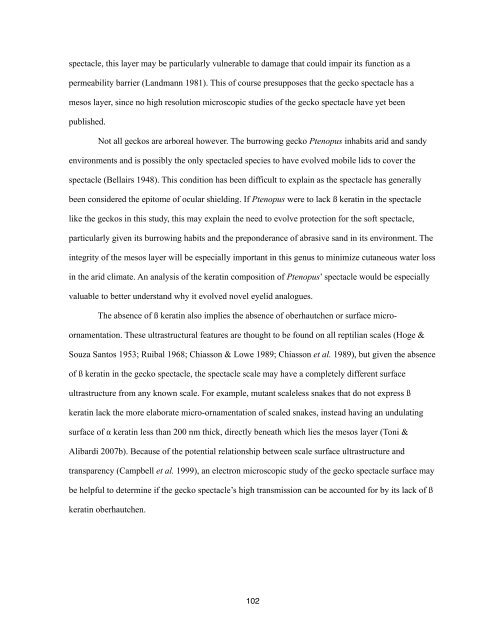Chapter 1, The Reptilian Spectacle - UWSpace - University of ...
Chapter 1, The Reptilian Spectacle - UWSpace - University of ...
Chapter 1, The Reptilian Spectacle - UWSpace - University of ...
Create successful ePaper yourself
Turn your PDF publications into a flip-book with our unique Google optimized e-Paper software.
spectacle, this layer may be particularly vulnerable to damage that could impair its function as a<br />
permeability barrier (Landmann 1981). This <strong>of</strong> course presupposes that the gecko spectacle has a<br />
mesos layer, since no high resolution microscopic studies <strong>of</strong> the gecko spectacle have yet been<br />
published.<br />
Not all geckos are arboreal however. <strong>The</strong> burrowing gecko Ptenopus inhabits arid and sandy<br />
environments and is possibly the only spectacled species to have evolved mobile lids to cover the<br />
spectacle (Bellairs 1948). This condition has been difficult to explain as the spectacle has generally<br />
been considered the epitome <strong>of</strong> ocular shielding. If Ptenopus were to lack ß keratin in the spectacle<br />
like the geckos in this study, this may explain the need to evolve protection for the s<strong>of</strong>t spectacle,<br />
particularly given its burrowing habits and the preponderance <strong>of</strong> abrasive sand in its environment. <strong>The</strong><br />
integrity <strong>of</strong> the mesos layer will be especially important in this genus to minimize cutaneous water loss<br />
in the arid climate. An analysis <strong>of</strong> the keratin composition <strong>of</strong> Ptenopus’ spectacle would be especially<br />
valuable to better understand why it evolved novel eyelid analogues.<br />
<strong>The</strong> absence <strong>of</strong> ß keratin also implies the absence <strong>of</strong> oberhautchen or surface micro-<br />
ornamentation. <strong>The</strong>se ultrastructural features are thought to be found on all reptilian scales (Hoge &<br />
Souza Santos 1953; Ruibal 1968; Chiasson & Lowe 1989; Chiasson et al. 1989), but given the absence<br />
<strong>of</strong> ß keratin in the gecko spectacle, the spectacle scale may have a completely different surface<br />
ultrastructure from any known scale. For example, mutant scaleless snakes that do not express ß<br />
keratin lack the more elaborate micro-ornamentation <strong>of</strong> scaled snakes, instead having an undulating<br />
surface <strong>of</strong> α keratin less than 200 nm thick, directly beneath which lies the mesos layer (Toni &<br />
Alibardi 2007b). Because <strong>of</strong> the potential relationship between scale surface ultrastructure and<br />
transparency (Campbell et al. 1999), an electron microscopic study <strong>of</strong> the gecko spectacle surface may<br />
be helpful to determine if the gecko spectacle’s high transmission can be accounted for by its lack <strong>of</strong> ß<br />
keratin oberhautchen.<br />
102
















